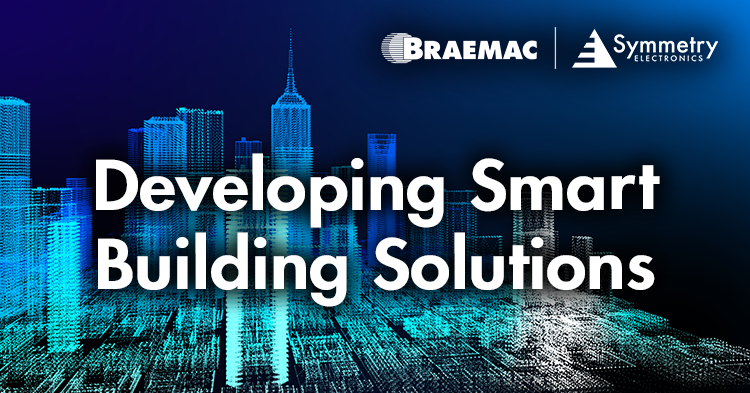- Home
- Symmetry Blog
- Developing Smart Building Solutions
Developing Smart Building Solutions
About Braemac Americas Team

It is 7:45 AM, and you’re driving to work. You pull into the office parking lot, where the gate automatically opens after a license plate recognition system reads your plate. You get out of your vehicle and make your way to the building. As you approach the door, an access system recognizes your face and opens it. Your entry is confirmed by a soft chime. After greeting a coworker, you settle into your desk chair. The lighting adjusts to a comfortable brightness and the HVAC system lowers the temperature slightly, having learned your preferences.
This is just the start of a day’s work for a smart building – sensing, adjusting, and communicating in the background, without you being aware of most of it.
For building owners and operators, smart buildings offer numerous benefits, including reduced energy consumption, lower operational costs, and improved occupant comfort and security. Smart buildings can also command a higher market value and attract tenants. Additionally, smart technology can significantly increase a building’s lifespan by allowing for greater functionality, efficiency, and adaptability over time.
What are Smart Buildings?
Smart buildings contain sophisticated connected systems that control building operations. They offer capabilities to lower operational costs, enhance security, and improve building performance. In a world of connected solutions, more buildings are being designed or retrofitted with intelligent infrastructure. The global smart building market was valued at $117.4 billion in 2024 and is expected to reach $548.5 billion in 2032. With 70% of the world’s population expected to shift to urban areas by 2050, smart building growth is anticipated to follow this trend.
4 Defining Features of a Smart Building
1. Internet of Things (IoT) Sensor Integration
IoT sensors provide smart buildings with the data needed to make intelligent decisions. Examples of applications within a building that can benefit from sensors include:
- Air quality sensors that detect smoke and vapors
- Smart lighting sensors that turn lights on or off based on occupancy
- Smart HVAC to control temperature and humidity, adjusting for occupancy levels, prevailing temperatures, and weather forecasts
- Smart windows that automatically lighten or darken, reducing energy load and glare
- Preventative maintenance – analytics and AI to detect abnormal patterns
- Security – access control, motion detection, smart cameras, and smart elevators
- Fire detection and suppression
2. Data Analytics
Data analytics provide smart buildings with actionable insights from data gathered from the sensors. Without proper data analytics, the information gathered from sensor technology cannot drive informed decisions. Data analytics help smart buildings discern the correct response to fluctuations within their systems.
Smart Building Applications
Source: SpringerOpen
3. A User Interface
4. Connectivity
- Wi-Fi 6/6E, Wi-Fi 7, and Ethernet/PoE provide high-speed, low-latency connectivity for environments with a high density of devices
- 5G, NB-IoT, and LTE-M enable scalable wireless communication and remote monitoring
- LoRaWAN®, Zigbee, and Thread support low-power, long-range communication for sensors, automation, and building management
Performance Starts at Design
Connected Ecosystems for Greater Sustainability
- Improved safety
- Reduced energy consumption
- Cost reduction
- Increased wellbeing
Smart Building Solutions Available at Braemac Americas
The Sensirion SEN6x series of air quality sensing modules measure key environmental parameters, including particulate matter, humidity, temperature, VOC, NOx and either CO2 or formaldehyde – in a single, compact package. With Sensirion’s extensive experience in environmental sensing, these modules deliver exceptional performance and superior longevity. With all relevant algorithms in one device, the SEN6x simplifies integration and streamlines the supply chain to accelerate time to market.
The Veda SL917 from Ezurio is an ultra-low power connectivity solution for next-gen wireless IoT. Designed for ultra-low power industrial IoT connectivity, the Veda SL917 series supports Wi-Fi, Bluetooth®, Matter, and IP networking for secure cloud connectivity. The SL917 is well suited for devices needing extended operating and battery life, such as building access control sensors, HVAC controllers, and wireless security cameras.
The Lantronix LS series is a managed layer 2+ Gigabit PoE++ Ethernet switch offering a small footprint, hardened temperature rating, and cloud-based management. It is ideal for IoT and IP devices throughout smart buildings. The product comes integrated with Lantronix’s cloud-based Percepxion™ software platform to optimize device life cycle management, enterprise application integration, and data analytics. Easy to employ and manage, the LS Series helps lower maintenance costs, improving building efficiency and enhancing the occupant experience.







